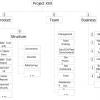|
When In Doubt, Throw It Out Peter Clark's company recently embarked on a "Lean Office" initiative. Now, Peter thinks many of you have steam shooting out of your ears just from reading those words. You probably think that it is just another lame management initiative that will take valuable time away from what is really important: coding and (maybe) testing. But in this week's column, Peter explains why this is the best initiative yet. |
Peter Clark
June 28, 2006 |
|
|
Pair Programming Observations Say "pair programming" to a programmer and he'll probably frown or turn his back on you. But add some rules the programmers must follow--rules that help maintain each person's sanity--and he just might come to find this practice rewarding and beneficial. This article, originally published on Jeff Langr's website, explains the rules and how certain teams have reacted to this structured version of pair programming. |
||
|
Communication During a Crisis When a crisis hits a business, you've got to work hard and fast to mitigate the negative consequences--a process which includes communicating with your clients. In this week's column, Payson Hall reminds us that keeping clients in the know is critical to a successful recovery and will stabilize the clients' faith in you, even when all has failed. Drawing from a recent crisis in which he was the client, Payson gives us key points to consider the next time we are overwhelmed by customers who want to know when business will return to normal. |
||
|
Best Practices In Global Agile Development For Product Innovation Agile over the wire and how to make it work. In our experience, pure-play Agile development is destined to fail in a global delivery model. The basics of Agile, such as the emphasis on face-to-face communication, close interaction between teams and an adaptive approach to product development, are not possible while engaging an offshore team. However, by injecting process adaptations, Cognizant has successfully enabled some facet of "specially customized" Agile methodologies. In fact, a large percentage of Cognizant's software product innovation services use Agile practices in some form or the other. |
||
|
Iteration and Release Retrospectives: The Natural Rhythm for Agile Measurement At regular intervals, the team reflects on how to become more effective, then tunes and adjusts its behavior accordingly. (Agile Manifesto principle 12) A cornerstone of agility is the team's commitment to continued reflection and adaptation. For most teams, there is a natural cadence to this process as iterations occur frequently, typically every one to two weeks apart, and releases occur every two to four months. As such, the iteration boundary represents a frequent opportunity for immediate feedback and quick mid-course correction, primarily focused on the team's ability to simultaneously define, code and test new functionality in a time box. At the release boundary, the measures move to those things that reflect the team and the organizations ability to move that functionality from "inventory" to delivered product or system. In this article, we'll describe a set of iteration and release metrics that have been used to good effect by a number of agile teams. In our experience, teams that are effective in using these iteration and release metrics have the best chance to achieve the maximum benefits of agile. |
||
|
5 C's of Agile Management By focusing on the 5 C's of agile development: Courage, Context, Course, Cadence, and Cost - software will never become "easy" but it will become easier, and better managed. Learn how each of these aspects cannot be ignored to run a successful project. |
||
 |
Calculating Earned Business Value For An Agile Project It is apparent that agility works, whatever that may mean. However, many software projects remain artifact-driven and waterfallish. Why is this? The most common excuses are that agility is too developer-centric, that it is too lightweight, and that feedback to business is hard to understand. In particular, many managers in larger companies miss their metrics. In this paper we address this last problem by defining a new metric, Earned Business Value (EBV), that replaces standard Earned Value Analysis (EVA) metrics, and can be calculated in an agile project. Using EBV, teams can gain better understanding of a project's progress and determine when and where to reallocate resources or change course. |
|
|
Rhythms as Agile Diagnostics A healthy agile project has several typical rhythms such as releases, iterations, stand-up meetings, builds kicked off by continuous integration, and the red-green-red test cycle of a developer. These rhythms have healthy ranges (such as a stand up meeting lasting less than 15 minutes) and characteristics (such as that same stand up meeting not containing design discussions). When they fall out of these ranges or do not display the appropriate characteristics, they indicate that something is wrong with the agile process. |
||
|
Understanding Introversion and Extroversion Personality differences often pose challenges for people who need to work together. One such difference is that which separates introverts and extroverts. Just by being themselves, introverts and extroverts can drive each other crazy. But they can also benefit from each other's strengths. In this column, Naomi Karten explains this personality difference and helps introverts and extroverts better understand and appreciate each other. |
||
|
Venkat Subramaniam - Practices of an Agile Developer - NFJS Tour 2006
Podcast
Venkat Subramaniam talks about his new book Practices of an Agile Developer during the NFJS Tour 2006 in Reston, Virginia. The practices are laid out in a way that eases adoption for people new to Agile and improves the practices for those who have been doing Agile. |
Pages
Upcoming Events
| Apr 28 |
STAREAST Software Testing Conference in Orlando & Online |
| Jun 02 |
AI Con USA Bridging Minds and Machines |
| Sep 22 |
STARWEST Software Testing Conference in Anaheim & Online |
| Oct 13 |
Agile + DevOps USA The Conference for Agile and DevOps Professionals |







